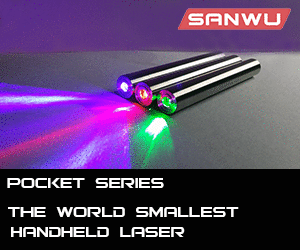Gryphon
0
- Joined
- May 4, 2009
- Messages
- 2,328
- Points
- 113
I just happened to notice that one of my 445s had a loose window, so i
figured it would be a good opportunity to decan and submerge it. The water
i used for this was nothing fancy just regular tap water. Power was
provided by my modded PSU and the diode was driven by my variable driver.
When powering 445s it can provide 50~1100mA so it was perfect. The
diode can was removed by placing it in the chuck of my hand drill and
spinning it up with a box cutter up against it (not rocket science but it
worked). Now all that was left was to hook it up and dunk it under.
Not surprisingly it worked fine, at just over 200mA the diode began to lase.
As i turned up the current however the ouput did begin to shift and warp.
Now i have watched the ouput pattern on these diodes alter as you ramp
the current up for 200mA to 1000mA, but this time it was different. The
whole ouput pattern seemed to hop and jump all over the place. My guess
it that bubbles forming on the diode were acting like little lenses and skewing
the ouput every which way as the grew and merged. In the video you can
see the resulting bubble is quite big.
The punch line is, this diode died during these *cough tests cough* but
really it was just an excuse to destroy a perfectly good diode and get some
pics and video
Make sure you heatsink your diodes, the last couple of secs of the video
show just how much heat they are capable of producing.
this empty space should help keep the Youtube video from appearing over these photos when you enlarge them
figured it would be a good opportunity to decan and submerge it. The water
i used for this was nothing fancy just regular tap water. Power was
provided by my modded PSU and the diode was driven by my variable driver.
When powering 445s it can provide 50~1100mA so it was perfect. The
diode can was removed by placing it in the chuck of my hand drill and
spinning it up with a box cutter up against it (not rocket science but it
worked). Now all that was left was to hook it up and dunk it under.
Not surprisingly it worked fine, at just over 200mA the diode began to lase.
As i turned up the current however the ouput did begin to shift and warp.
Now i have watched the ouput pattern on these diodes alter as you ramp
the current up for 200mA to 1000mA, but this time it was different. The
whole ouput pattern seemed to hop and jump all over the place. My guess
it that bubbles forming on the diode were acting like little lenses and skewing
the ouput every which way as the grew and merged. In the video you can
see the resulting bubble is quite big.
The punch line is, this diode died during these *cough tests cough* but
really it was just an excuse to destroy a perfectly good diode and get some
pics and video
Make sure you heatsink your diodes, the last couple of secs of the video
show just how much heat they are capable of producing.
this empty space should help keep the Youtube video from appearing over these photos when you enlarge them
Attachments
Last edited:










